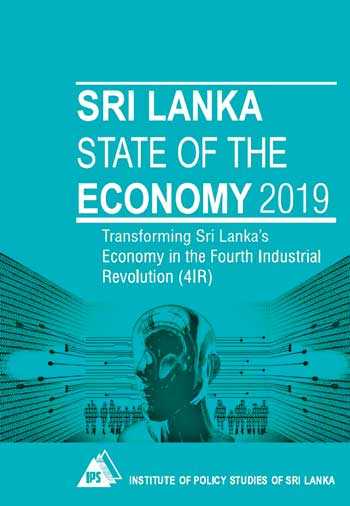Monday Jan 19, 2026
Monday Jan 19, 2026
Wednesday, 23 October 2019 02:06 - - {{hitsCtrl.values.hits}}

At its most basic level, a significant proportion of 4IR technologies are emerging around the use of computers and the IoT. Therefore, low levels of computer literacy and internet access create considerable obstacles for Sri Lanka to absorb, implement and leverage 4IR technology
Technological evolution has become a cornerstone in human interactions across multiple spectrums, be it economic, social, cultural or otherwise. The Fourth Industrial Revolution (4IR) is expected to make notable changes to the way people work and live. However, unlike other industrial revolutions, 4IR technologies are significantly more invasive, complex and rapidly evolving. The tangible changes to social and economic structures already taking place in developed and developing countries alike are observable. Against this backdrop, the importance of the 4IR and Sri Lanka’s preparedness for it are also gaining growing interest.
Policy challenges for developing economies
In 4IR, technological adoption is fast-paced and mainly concentrated in developed economies. That said, developing countries need to be proactive in investing in leading or at least preparing for the digital transformation. Failure to do so could potentially lead to certain technologies being too overwhelming to adopt and adapt to, leading to countries being left behind in the development process. Developing countries therefore are required to address both existing structural reforms as well as pre-emptive policymaking. On structural factors, low access to electricity and the internet, low computer literacy rates and low levels of labour mobility are issues that require urgent attention.
Meanwhile, the mobilisation of cheap labour is arguably one of the biggest comparative advantages of many developing countries. However, the 4IR is likely to displace jobs mostly in these sectors. Therefore, developing countries will have to focus on reforms to their educational and training systems, from primary to tertiary and vocational, to ensure that the labour force can adequately respond to any displacement that may occur. Successfully transitioning to a ‘knowledge economy’ requires a greater focus on Science, Technology and Innovation (STI) policies. Not only does this require an environment that facilitates investment in research and development but also one which mitigates factors such as a brain drain.
Sri Lanka and the 4IR
Similar to other developing countries, Sri Lanka too has to focus more on technological preparedness as well as creating a complementary economic ecosystem to benefit from the 4IR.
Digital readiness
At its most basic level, a significant proportion of 4IR technologies are emerging around the use of computers and the IoT. Therefore, low levels of computer literacy and internet access create considerable obstacles for Sri Lanka to absorb, implement and leverage 4IR technology. A mere 34% of the population uses the internet. There are significant disparities in IT literacy levels between the urban (36.9%), rural (22%) and estate (8.6%) sectors. These disparities thus indicate the significant structural weaknesses of Sri Lanka’s digital readiness for the 4IR era. On innovation, amidst marginal gains in recent years, Sri Lanka continues to be ranked considerably low in the Global Innovation Index by the World Intellectual Property Organisation (WIPO).
Human capital readiness
Human capital readiness refers to the ability of an economy to respond to shifts in labour markets from both the demand and supply side. In addition, it depends on a current labour force’s capacity to adopt and use emerging technologies while also cultivating the right skills and talents for a future workforce. Sri Lanka has long been touted for its high literacy rate. However, basic literacy and numeracy-based employment are likely to suffer most due to the 4IR. The country’s relatively low level of enrollment in tertiary education is therefore a cause for concern. Thus, Sri Lanka is badly placed in terms of responding to disruptions caused by the 4IR. Moreover, the economy will also be challenged to benefit from technology spill-overs and other ancillary benefits that may come through foreign direct investment (FDI) and integration into global value chains as its labour force becomes unattractive to high-tech, 4IR-based industries and investments.
Economic agility
Sri Lanka’s current economic structure is still at a very early stage of introducing 4IR technology and has in fact been left behind on some counts. On complexity and the future of production, the product space of Sri Lanka’s manufacturing and agriculture sectors has largely remained stagnant over the years. Despite the growing contribution of the services sector to GDP, a significant portion of growth in the sector has been in non-tradable services such as transport and retail. Even though these services have not experienced any significant introduction of 4IR technology, the eventual prevalence of technologies like self-driving vehicles will create considerable disruptions to the labour market as well as the structure of the sector.
Way forward
The 4IR can easily be integrated into any facet of socioeconomic policy and is uniquely capable of being tailored to address narrow policy objectives as well as wider issues. However, while the technology is modern, its efficacy depends on how agile and complementary a country’s economic and social ecosystems are for technological absorption, implementation and innovation.
Under these circumstances, Sri Lanka is still considered a nascent economy in its preparedness for the 4IR. The country has not thus far created a conducive ecosystem that facilitates the integration of modern technologies into the economic and social facets of daily life. Success therefore depends heavily on identifying and addressing wider structural and institutional impediments, followed by a careful diagnostic of each economic subsector and recognising how the 4IR can be leveraged for greater and more inclusive economic growth.
(This policy insight is based on a chapter written for ‘Sri Lanka: State of the Economy 2019’ on Transforming Sri Lanka’s Economy in the Fourth Industrial Revolution. The chapter is authored by Kithmina Hewage, Research Economist at the Institute of Policy Studies of Sri Lanka)